If you have a garden, you’re probably familiar with hedges. In case you aren’t, here’s the deal: hedges as living walls, comprising of plants. While certain hedge or border plants are entirely decorative, others are often tailored to meet practical tasks.
Regardless of their practical use, hedges are primarily used for decorating garden borders and they often pruned to perfect sizes. Available as Evergreen and Deciduous variants, these shrubs serve the perfect border to any garden.
Since they grow densely and often come with thorns and prickly leaves, hedges are often known to serve the purpose of garden security. In some instances, they also turn out to be immensely useful as a privacy screen or a windbreak.
But when it comes to edging plants, what exactly should look for? Which edging plants are slightly better than their counterparts? Also, which of these plants are the easiest to grow? Well, these are some of the questions we will explore over the course of this article. Read on, to find out more about 13 Evergreen Edging Plants that’ll serve the perfect border to your garden.
1. Hosta
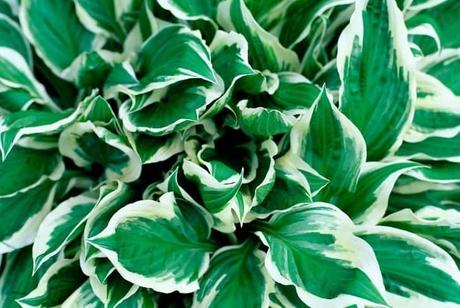
If you’re looking for a beautiful garden plant, the Hosta plant might just be your best bet. Ideal for both partial and full shade gardens, these plants serve as an excellent border shrub. One of the most unique qualities of the Hosta lies in its unique leaf patterns.
These plants are also extremely versatile and you can choose them from multiple species. Depending on the type of plant you get, they may grow up to 10 inches. In some cases, however, they assume a loftier height ranging up to 2 feet.
The Hosta is a flowering plant and it comes with vibrant white, bluish, and purplish flowers that often attract butterflies and birds during late summer and springs. These plants thrive best in hardiness zones ranging from 3 to 9 and while buying them, it is recommended you buy them as bulbs.
2. Lilacs
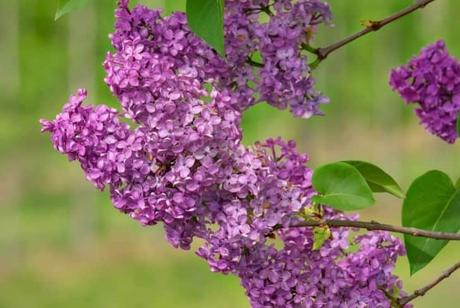
These are deciduous hedge shrubs that appear amazing when in full bloom. They usually grow in USDA zones ranging from 3 to 7 and bloom even during the colder winter months. Lilacs blooms are available in multiple vibrant hues like Lavender blue, white, magenta, burgundy, pink, and even white. They require full sun and thrive best in loamy soil with a neutral pH level.
One of the striking aspects of Lilacs lies in the fact that they drop their leaves and stand out with a fully blooming flower. This doesn’t just create an excellent border to your garden but also serves as a great privacy screen.
You might also want to choose Lilac bushes if you want a fragrant edging plant for your garden. To create a border, just plant several lilac plants in a straight line. These plants perfectly conform to multiple dimensions and you would love having them home.
3. Mophead Hydrangea

This is yet another excellent edging plant that is best known for its beautifully blooming flowers. The Mop Head Hydrangea derives its name from the cluster of flowers resembling a mop.
Flowers are usually available in shades of pink, magenta, white, and even blue. They thrive best in areas with moist soil and warm sunlight. So, if you are planning to use them as a border plant, make sure you consider these parameters before anything else.
Mop head Hydrangeas are usually medium-sized and they can be used for separating garden rooms and corridors with their dense foliage and pretty blooms. While their size makes them perfect for a standalone plant, you can also combine them with other shrubs like the Hosta or your preferred fern.
The plant thrives best in USDA hardiness zones 5 to 11 and they are available both as bulbs and potted plants. If you are a novice gardener, we recommend the potted variant for ease and less hassle.
4. Canadian Hemlock
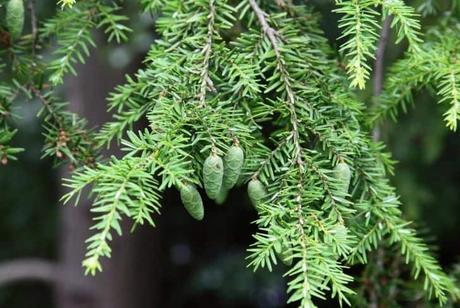
While these plants usually grow as big trees when in wild, you will also find their smaller variants as medium-sized shrubs. Canadian hemlocks thrive best in hardiness zones 3 to 7 and they require partial exposure to the sun and partial shade in equal amounts. In terms of soil, you need to be extra careful, as the Canadian Hemlock only thrives well in rich, moist, and slightly acidic soil.
While growing these shrubs at home, you might have to do some light pruning during the first couple of growing seasons. Ideally, you should prune them at least 2 to 3 times between late June to August for the first 2 to 3 years.
Once you cross this stage, the plant will only require annual pruning in the month of June, ideally later part. Avoid cutting the leaders up to the hemlock hedge or windbreak might hinder its height and growth.
5. Privets
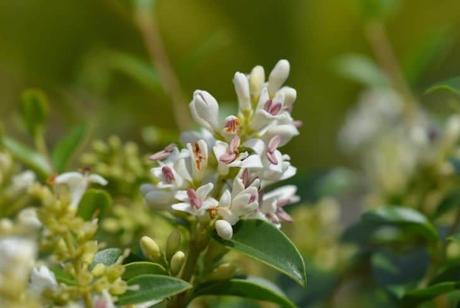
Privets are almost like mountain laurels. They can be best defined as broadleaf shrubs that are known for their beautiful blooms with white flowers. In fact, the flowers alone serve as one of the biggest selling points for these shrubs. While Privets are usually known to be evergreen, all variants of the plant may not suffice this category
. To be extra-sure, we recommend you consult your local county extension for checking if these plants can be grown in your area. Ideally, privets do well in US hardiness zones ranging from 5 to 8. For best results, they require partial sun.
That means, unlike many popular shrubs, Privets can tolerate some amount of shade. While the plant is tolerant of almost all soil types, it is recommended to keep the soil moist.
6. Jugut Mudun (Justicia Gendarussa)
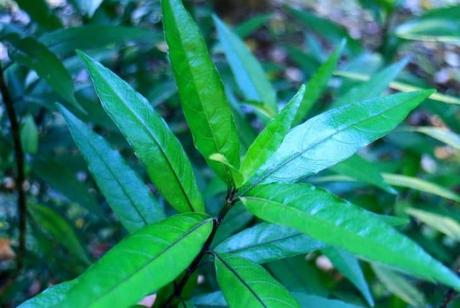
If you’re looking for a perfect edging plant, the Jugut Mudun is an excellent option. This plant appears like dwarfs with leaves that completely resemble lances. The Jugut Madan prefers areas receiving ample rainfall, and you can easily grow them at home by propagating the cuttings during monsoon months.
While planting them at home, also note that the Jugut Mudun is especially fond of shade. So, you can always plant them by the roadside where they are duly shaded by stunning trees. The Jugut Muduns need to be clipped twice on an annual basis and their height needs to be eight inches.
7. Lady’s Mantle

This plant is as beautiful as its name. Known for its scallop-shaped leaves, the Lady’s Mantle is almost always covered by tiny, and extremely fine hairs. The most unique feature of these plants lies in their foliage that has an almost glistening effect when the morning and evening light falls on them.
The foliage looks even prettier when it manages to catch a couple of dewdrops in the early mornings. The plant is known to bloom during the early summer months with a beautiful cluster of flowers. These flowers alone make an excellent edge for any garden or lawn. While the Lady’s Mantle doesn’t have any specific growing requirements, they thrive best in zones 4 to 7.
8. Tricolor Sage

The Tricolor sage is of course a perennial herb that also makes one of the best garden borders. Their defining feature lies in the fact that they are both edible and ornamental. The leaves of the Tricolor Sage have the same appearance and flavor that you are familiar with.
Their edges are white with a dash of pink and purple in the middle. The plant blooms during the summer months and their vibrant blooms are known to attract pollinators like butterflies and bees.
The sage can assume a height of 18 inches, and it thrives best under full sun. In terms of soil, you can use dry or sandy variants that cannot retain much moisture.
9. Lobularia
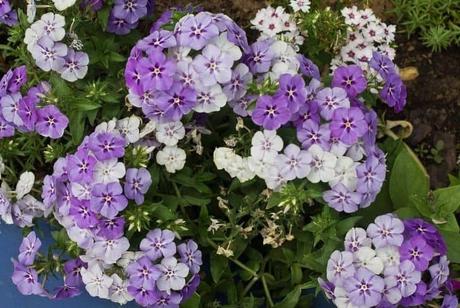
Commonly known as the Sweet Alyssum, the Lobularia derives its name from its stunningly aromatic blooms. The plant is known to survive in a wide range of climates including both extreme heat and drought.
While certain species of the plant will halt blooming under the scorching summer heat, others like the Snow Princess have been artificially developed for continuously blooming regardless of the waves.
Lobularia prefers moderately moist and completely well-drained soil. So, if you live in a zone with mild summer, consider planting it in a spot where it receives complete sunlight.
10. Moss Phlox
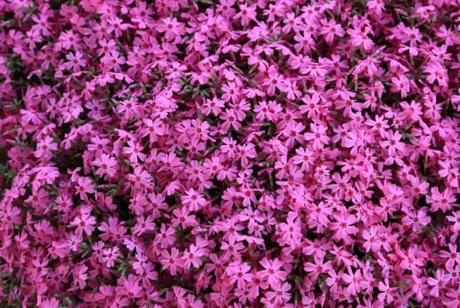
This is probably one of the most low-maintenance border plants. It is known to be drought-tolerant and can fill up any empty landscape space really well. That is also the reason why you might have come across the plant as ‘creeping phlox’.
The Moss Phlox can assume a height of up to 6 inches and a width of 1 to 2 feet. It blooms during April and May and attracts plenty of butterflies every summer. The plant thrives best in moist, well-drained soil, and requires full sun to bloom. Unlike other border plants, it is also known to withstand rocky and sandy soils.
11. Barrenwort
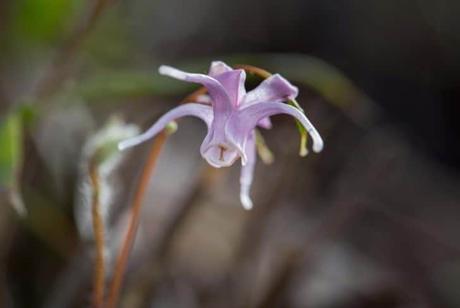
If perky perennials are what you are looking for, Barrenworts will certainly serve your purpose. One of the best options for shaded landscape beds, these plants bloom during the Spring months with a beautiful set of flowers. The most unique aspect of the flowers lies in the fact that they almost appear spidery in a wide array of shades like pink, violet, magenta, occur, white, and more.
Several varieties of the Barrenwort are known for their stunning foliage that assumes a bronzy shade during the autumn months. Barrenworts thrive best in hardiness zones 5 to 9.
12. Snowbank False Aster

If you are looking for a fairly large edging plant, the Snowbank False Aster might be your option. These plants are known for their massive size and super-fine texture. Thanks to their qualities, they can serve as an excellent addition to the center or back of your garden border.
The flowers are super-small, almost similar to daisies, and you will find them blooming in late summer and spring months. In some instances, however, the flower may even continue to bloom until the fall.
While growing them at home, make sure they receive ample sunlight and completely well-drained soil. This will also entirely eliminate the need for staking.
We are especially fond of the Snowbank atter because their flowers seem like a burst of the cloud has emerged in your garden. Such is their beauty, that they can charm any random landscape.
13. Thrift

This is an excellent edging plant for anybody who’s looking for a mound of dense, grassy foliage. The leaves feature tiny clusters of pink, yellow and white flowers during the early summer and spring months. The plant thrives best in full sun and moist soil in hardiness zones 3 to 9.
Since it is practically impossible to list out every individual evergreen shrub there is, we’ve focused on the plants that we personally endorse. These listed plants aren’t just simple to grow but they also add just the right charm to your garden space. So, explore your options and choose the perfect edging plant that’ll deck up your garden and add just the right charm.
References


